
2010 1st Issue
Feature Articles
(I) Safe Supply of Korean Barbecue Food
| Boss: | Is the food for dinner session ready, Captain? |
| Captain: | Table setting is underway. |
| Chef: | Preparatory work in the kitchen has been finished. The meats have been sliced as thin as possible for easy cooking. Besides, meats which have been marinated for some time are separated from those just marinated. We will stick to the "first-made-first-out" principle for supply and avoid mixing them together in order to ensure the freshness of the food. |
| Captain: | We have checked that both the refrigerators and the hot-holding cabinets are operating well. We display raw and cooked food at different places. To avoid cross-contamination, separate utensils are provided for the customers to pick raw and cooked food. We also provide two different sets of utensils on the dining tables for handling of raw and cooked food separately. |
| Boss: | Chef, what about the batch of problematic food we received in the last order? |
| Chef: | We have already discarded that batch of food and changed to another supplier. It's hard to have the quality ensured with such a low price. We now buy food from reliable suppliers and will check the quality with the delivery. If the food is not fresh, for example, seafood with bad smell or broken shell, the packing is defective or the expiry date has passed, we will return the batch to the supplier immediately. |
| Boss: | I just read some information from the website of the Centre for Food Safety that a group of carcinogenic compounds called polycyclic aromatic hydrocarbons (PAHs), may be formed and released when meat is barbecued. PAHs are found everywhere in the environment and are present in almost all food. A high level of PAHs may not be often found in raw food. However, cooking methods such as roasting and grilling will generate PAHs and result in a higher level of PAHs in the food. Also, charred food of almost any composition contains PAHs. People eating a lot of barbecued or grilled food will therefore have a higher intake of PAHs. According to the International Agency for Research on Cancer, certain PAHs compounds are probably carcinogenic to humans. |
| Captain: | I think we'd better remind customers not to eat charred food. |
| Boss: | When meat is in direct contact with a flame during cooking, pyrolysis of fats in the meat generates PAHs. In addition, when the melted fat drips from the meat onto the heat source, it will generate PAHs which in turn will be deposited on the meat surface as the smoke rises. |
| Chef: | I see. Therefore, when we prepare food in future, we can choose lean meat and trim visible fat to avoid fat dripping onto the heat source. Also, we can partially cook meat in boiling water to reduce the barbecuing time. By doing so, the level of PAHs should be reduced. |
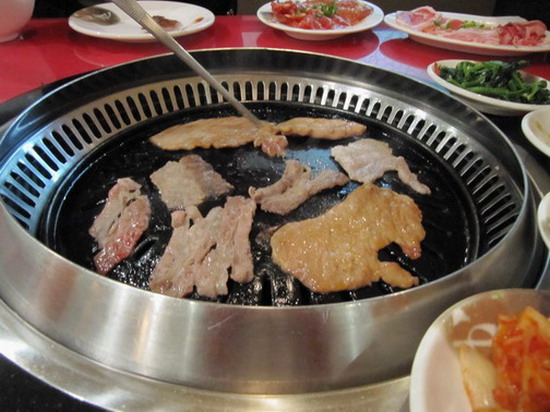
(II) Handle Preserved Vegetables with Care
| Manager Chan: | Chef, what are your specials for customers tonight? |
| Chef Ming: | Braise belly pork with preserved mustard green, steam minced pork with preserved Sichuan mustard and …… |
| Manager Chan: | Why are there preserved vegetables in both dishes? |
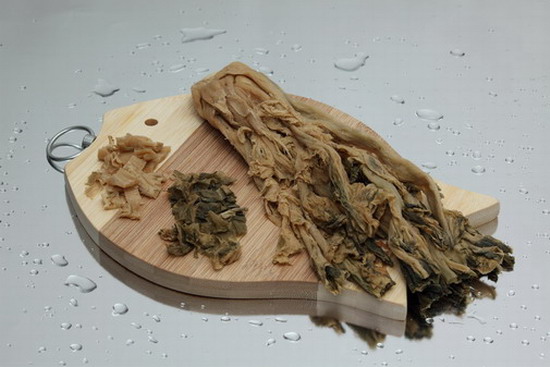
| Chef Ming: | The grocery store downstairs sold us a batch of preserved vegetables at a very cheap price. That is why there are preserved vegetables in every dish tonight. |
| Manager Chan: | Chef Ming, How's the quality? |
| Chef Ming: | They are fine. Although the preserved mustard green does not look good with holes on the leaves, the preserved Sichuan mustard looks fine. |
| Manager Chan: | Don't be so sure. If the food ingredients are problematic, they may result in food poisoning, and other serious consequences. Our reputation will be tarnished |
| Chef Ming: | Aren't you a bit over exaggerating? |
| Manager Chan: | Preserved vegetables are made of raw and uncooked vegetables. Just look at the preserved mustard green. The holes on the leaves may be due to improper pickling process, which causes the breeding of worms. The preserved Sichuan mustard may look all right, but could too many preservatives have been added? Otherwise, it is not possible for them to be priced at only half the usual price. |
| Chef Ming: | How dare they! Let me return the stuffs right away. |
| Manager Chan: | Ming, we should buy food ingredients from reliable suppliers. If properly prepared, bacteriological safety of preserved vegetables is usually guaranteed with the use of vinegar, sugar and salt during pickling. However, pickling alone may be insufficient to kill the parasites in preserved vegetables. Bacterial contamination may also be caused by the unhygienic handling practices by food factory workers. Hence, we should wash the preserved vegetables and cook them thoroughly. |
| Chef Ming: | Got it. In addition, preserved vegetables may be added with two commonly used preservatives, sorbic acid and benzoic acid. Food manufacturers should follow the Good Manufacturing Practice and comply with the legal requirements in choosing the suitable type of preservatives. |
| Manager Chan: | Right! Prepackaged preserved vegetables should also meet the labelling requirements in the law. |
| Chef Ming: | Oh, no! We're left with nothing for the Chef's Specials tonight! |
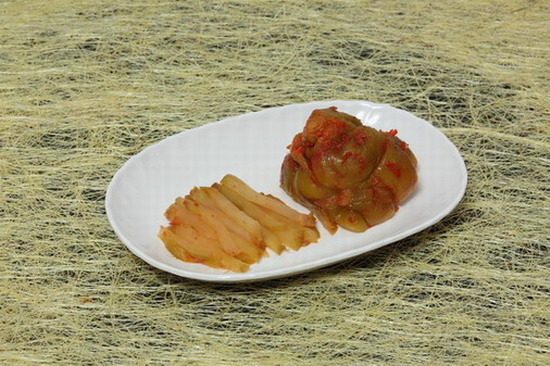
Readers' Corner
Newly developed Standards, Code of Practice and Guidelines by the Codex Alimentarius Commission
The Codex Alimentarius Commission (Codex) was established in 1963 by the World Health Organization and the Food and Agriculture Organization for the formulation of food standards, guidelines and relevant documents. The Codex holds annual meeting during which regional and national representatives deliberate and endorse food standards developed by its valid committees. The meeting of 2009 (the thirty-second session) was held from 29 June to 4 July in Rome , Italy . Various standards, code of practice (CoP) and guidelines on pesticides, veterinary drugs, food additives, food contaminants, etc were adopted at the meeting.
The main motions passed include the adoption of new or revoking of existing maximum residue limits for certain pesticide and veterinary drug residues, the adoption of Food Additive Provision of the General Standard for Food Additive, amendments to the International Numbering System for Food Additives and the adoption of new CoP for the prevention and reduction of certain food contaminants. For the full report of the thirty-second session of Codex and information on the newly adopted standards, CoP and guidelines, please visit the Codex website at:
http://www.codexalimentarius.net/download/report/728/al32REPe.pdf (for English version)
http://www.codexalimentarius.net/download/report/728/al32REPc.pdf (for Chinese version )
The Centre for Food Safety will, in phases, consider adopting the standards, CoP and guidelines of Codex as relevant to Hong Kong . The trade should observe the existing standards laid down in local law and guidelines, and refer to the Codex Standards when local standards are not available. If there are no relevant standards available in Hong Kong, members of the trade may then refer to those adopted by Codex as these would be used as references in the enforcement of food safety in Hong Kong.
Regarding the new guidelines, here is a brief introduction of three CoP for the prevention and alleviation of contaminants commonly found in foods:
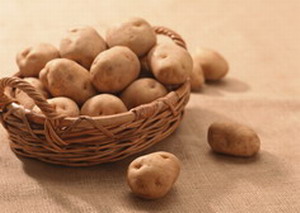
(A) CoP for the Reduction of Acrylamide in Foods –
Acrylamide is formed in carbohydrate-rich foods during high-temperature cooking. The new CoP provides guidelines in the prevention and reduction of the formation of Acrylamide in potato products and cereal products.

(B) CoP for the Reduction of Contamination of Food with Polycyclic Aromatic Hydrocarbons (PAHs) from Smoking and Direct Drying Processes –
PAHs are formed under many conditions, such as incomplete combustion of organic matters, forest fires, volcanic eruptions as well as industrial processes or other human activities, including the processing and preparation of food and the commercial and domestic preparation of food. The CoP provides guidelines in the prevention and reduction of the contamination of food with PAHs during commercial smoking and direct drying processes.
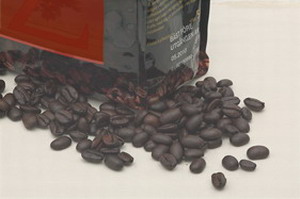
(C) CoP for the Prevention and Reduction of Ochratoxin A (OTA) Contamination in Coffee –
OTA is a toxic fungal metabolite found in cereal products and coffee. The CoP provides guidance in the prevention and alleviation of the contamination of coffee with OTA.
Food News
(I) Turn and Look for Healthier Food Choices
Nutrition Labelling Series - Know More About Wording Blacked Out or Covered on Food Packages
Why do I see food packages with some of the wording blacked out or covered?
The new Nutrition Labelling Regulation will come into effect on 1 July 2010 . The food trade has been taking corresponding measures actively to meet the new legal requirements. Increasing numbers of prepackaged foods are now provided with nutrition labels which contain the information on energy and seven specified nutrients (i.e. 1+7). In addition, you may also notice that certain wording on some food packages are blacked out or covered. This is mainly because:
Reason (1)
Under the new Regulation, prepackaged foods with small sales volume may apply for exemption from labelling the nutritional content but nutrition claims are not allowed to be made on these product packages. Therefore, some traders may black out or cover the nutrition claims on these product packages to render the products eligible for application for exemption. These exempted products will each bear a specific label to indicate their exemption status. Moreover, an exemption number will be marked either on the label or in close proximity to the place where the product is displayed for sale (e.g. on the shelf).

Reason (2)
Some prepackaged foods may have nutrition claims that are used overseas but not allowed under the new Regulation in Hong Kong . Therefore, some traders may black out or cover the relevant wording on the food packages to meet the requirements of the new Regulation in Hong Kong .
Different methods may be used to black out or cover the wording on food packages, such as using bold black pen to cross it out or using sticker to cover it. We hope that the explanation of the reasons for and the intentions of blacking out or covering certain information on the packages can help allay unwarranted concern of the public.

Critical Control Point of Preparing Bean Curd with Minced Pork in Chili Sauce
With a spicy flavour, Bean Curd with Minced Pork in Chili Sauce is undoubtedly an appetising dish for customers. Attention should be paid to some critical steps during the production of this dish for ensuring food safety. Below we provide with the preparation guidelines with special attention to these critical steps.
|
Ingredients |
|
| Bean curd | 2 pieces |
| Fresh minced pork | 200 grams (about 6 taels) |
|
Seasoning |
|
| Chili bean paste | 1 teaspoon |
| Dark soy sauce | 1 teaspoon |
| Shaoxing wine | 2 teaspoons |
| Salt | 1 teaspoon |
| Corn flour | 1 teaspoon |
| Pepper | a little |
Steps:
-
Rinse minced pork. Add Shaoxing wine, salt and pepper. Marinate for 10 minutes.
-
Rinse and dice bean curd.
-
Preheat the wok and add a tablespoon of oil. Add minced pork and cook briefly. Then add bean curd, chili bean paste, dark soy sauce and a bowl of water. Put on the cover and cook for 10 minutes. Add corn flour water, cook for 2 to 3 minutes and dish up.
Production Process
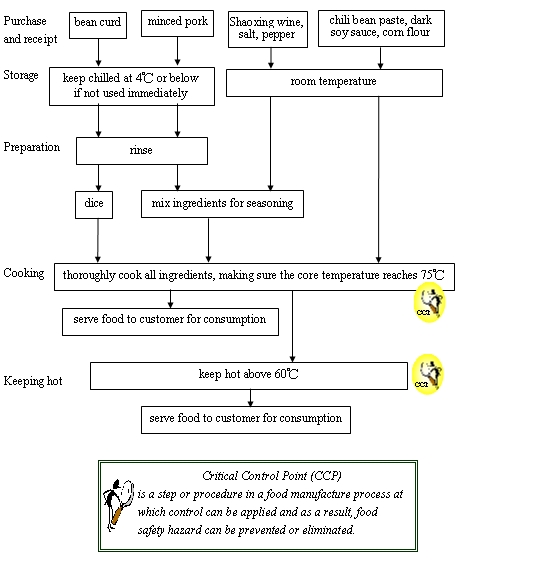
Guidelines on Production of Bean Curd with Minced Pork in Chili Sauce
- Purchase and receipt
-
Purchase the ingredients from reliable and hygienic suppliers.
-
When purchasing and receiving the ingredients, make sure they are fresh and wholesome.
- the fresh minced pork is purchased from a licensed fresh provision shop.
- all prepackaged food items (e.g. chili bean paste, dark soy sauce) are used before the expiry date.
-
- Storage
-
Store the ingredients at safe temperature as soon as possible.
- The fresh minced pork not for immediate use should be stored in a refrigerator. The temperature inside the refrigerator should be checked and recorded regularly with a thermometer to ensure that the fridge remains at 4 ℃ or below.
- The raw minced pork and bean curd should be stored in containers with lids and put under cooked food or ready-to-eat food to avoid cross-contamination. R aw food and cooked food should most preferably be stored in different refrigerators.
-
Practise the first-in-first-out principle for storage. Check and record the storage date of the ingredients.
-
- Preparation
-
Before cooking, wash all food contact surfaces (including worktops, chopping boards and utensils) thoroughly.
-
Before cooking / in the course of preparing food, wash hands thoroughly with running tap water and soap.
-
Use two different sets of utensils (including knives, chopping boards, bowls and chopsticks) to handle raw food and cooked food separately.
-
Before cooking, rinse the bean curd and minced pork.
-
The marinated minced pork not for cooking immediately should be stored in a refrigerator at 4 ℃ or below.
-
- Cooking
-
The food should be thoroughly cooked before consumption until the meat juice becomes clear and not red.
-
Use a clean food thermometer to measure the core temperature of the food, which should reach at least 75 ℃ . (CCP)
-
- Keeping hot / Consumption
-
The cooked food should be served to customers for consumption as soon as possible. It should not be kept at room temperature for more than 2 hours.
-
Cooked food not for immediate consumption should be kept hot in pre-heated plate or steam pot above 60 ℃. (CCP)
-
- Management System
-
Implement a preventive food safety management system (such as the Hazard Analysis and Critical Control Point) to help identify and control any food safety problems that may emerge during production.
-
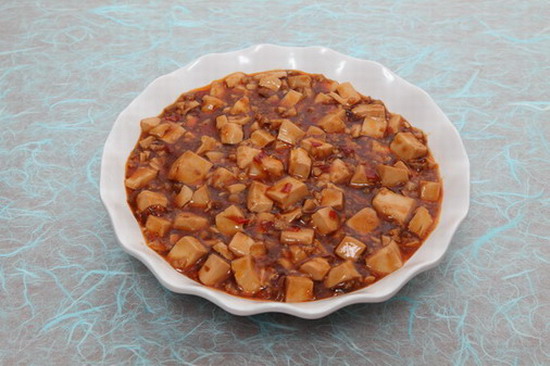
Briefing of Activities
Roving Exhibitions of "Food Safety Charter"
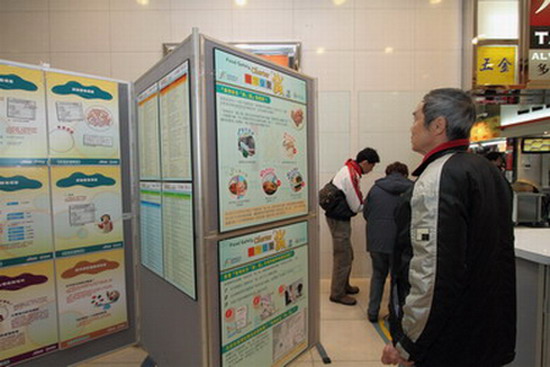
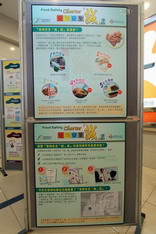
The Centre for Food Safety (CFS) has launched the "Food Safety Charter" since 2008. Members of the food trade are invited to sign up to the Charter. In 2009/10, a total of 21 food trade associations and more than 1 700 licensed food premises / supermarkets / convenience stores have signed up to the Charter.
In order to enhance public awareness of the 5 Keys and the Charter, roving exhibitions were held in 19 districts by the CFS. The public could identify the signatories in respective districts from the signatory list shown on the display panels and the computer provided at the venue.
Questions and Answers
Food Additives
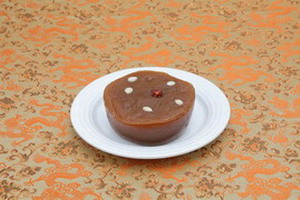
Q: I have consumed quite a lot of Chinese New Year foods during the festive period. Is there any control over the use of preservatives in those seasonal foods by the Government?
A: The Preservatives in Food (Amendment) Regulation 2008 sets out in details the permitted preservatives and antioxidants in different food categories and their maximum permitted levels. Since the preparation process and the ingredients can affect the categorization of the food, manufacturers are advised to take into account the ingredients and processing of their food products while referring to the permitted preservatives and antioxidants prescribed in the Regulation.
For details of the amended Regulation, please visit the following web page:
http://www.cfs.gov.hk/english/food_leg/food_leg_
pf.html#pf_sch1
Q: Some fruit and vegetable juices available on the market contain xylitol or other sweeteners. Is there any control over their use by the Government?
A: According to the "Interpretation" of the Sweeteners in Food Regulations (Cap. 132U), "sweetener" means any chemical compound which is sweet to the taste, but does not include any sugars or other carbohydrates or polyhydric alcohols. Sweeteners permitted to be used in food are set out in details in the Regulation. Given that xylitol is a kind of polyhydric alcohol, the Government does not object to the use of xylitol in food, but traders should ensure that their food products are safe for human consumption and comply with the provisions of the Public Health and Municipal Services Ordinance (Cap.132) and its subsidiary legislation. For details, please visit the web page:
http://www.cfs.gov.hk/english/food_leg/food_leg.html
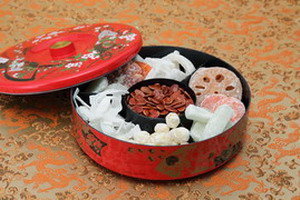
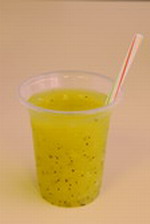
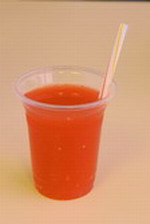
Truth against Fallacy
Safe Temperatures
|
? |
Since winter is cold, it is unnecessary to store leftover cooked food in a refrigerator. |
|
|
J Truth |
Wrong. Leftover cooked food should be cooled as soon as possible and kept in a refrigerator within 2 hours. Under favourable conditions such as in the "temperature danger zone" (between 4 ℃ and 60 ℃ ), even a bacterium can multiply to 4 000 in 4 hours and 2 million in 7 hours. |
Enquiry and Subscription
Printed copies of the Food Safety Express (Chinese version only) can be collected at the Communication Resource Unit located at 8/F, Fa Yuen Street Municipal Services Building, 123A Fa Yuen Street, Mong Kok, Kowloon. For enquiry, please call 2381 6096.